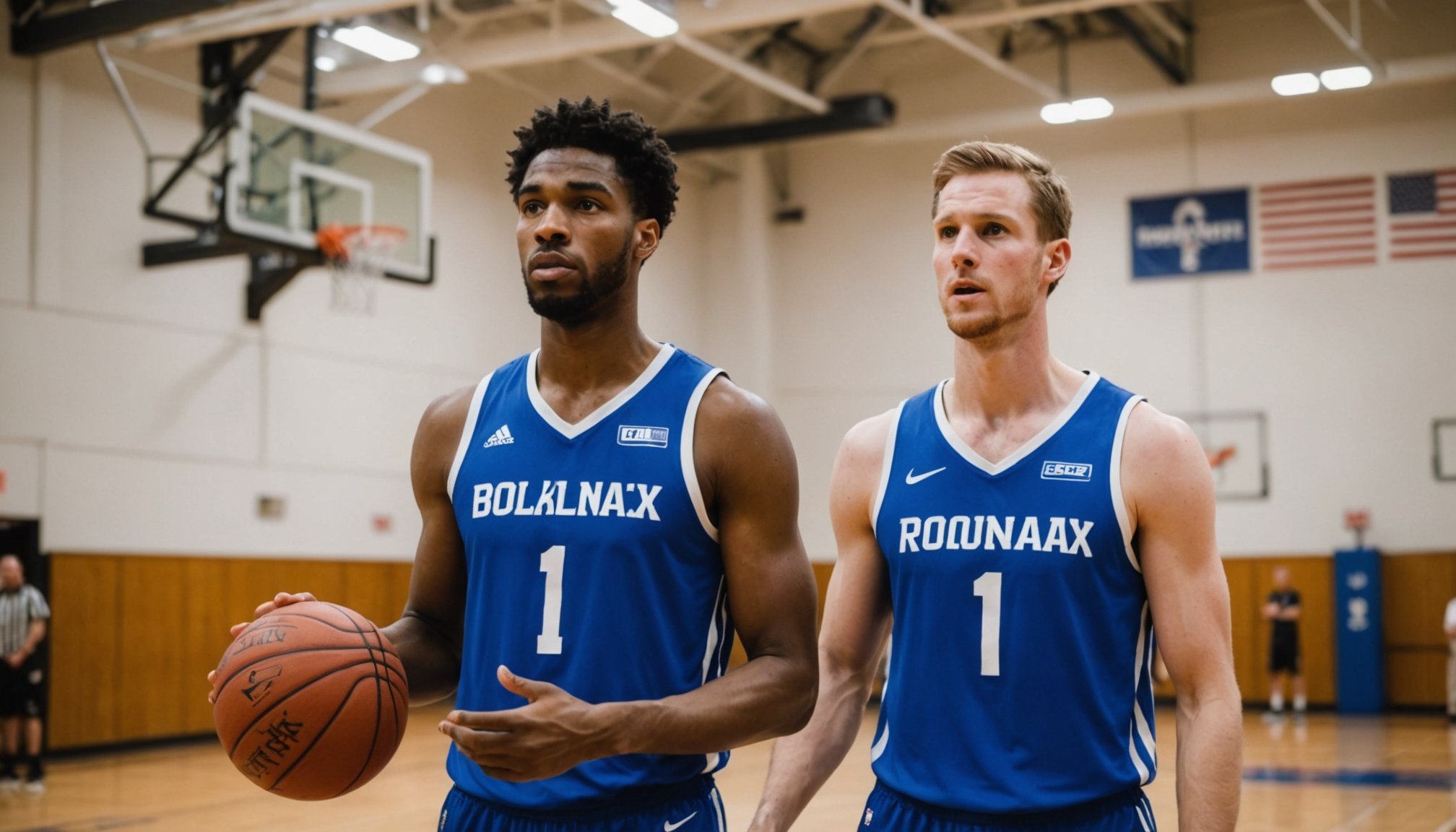Understanding Burnout in Basketball
Basketball can be both exhilarating and demanding, but burnout is a challenge many players face, impacting their well-being and performance. At its core, burnout is a state of emotional, mental, and physical exhaustion caused by prolonged stress. In athletes, this can manifest as a decreased sense of accomplishment, fatigue, and detachment from the sport they love.
Defining Burnout and Its Symptoms in Athletes
Burnout prevention starts with recognizing its symptoms. Players may feel persistent fatigue, reduced performance, and increased irritability. They might encounter emotional withdrawal from teammates and coaches, making it vital to address these signs early.
Topic to read : Revolutionizing Practice: Ways UK Basketball Teams Can Leverage Virtual Reality in Training
The Impact of Mental Strain on Basketball Performance
Basketball psychology underscores how mental strain affects an athlete’s game. Stress can diminish concentration and decision-making skills, leading to subpar plays and decreased efficiency. A player’s well-being is crucial; without mental clarity and motivation, even the most skilled players struggle to deliver their best.
Unique Factors Contributing to Burnout in UK Basketball Players
In the UK, basketball players face unique pressures. These include balancing academic obligations with training, limited access to resources, and high performance expectations from a burgeoning basketball scene. Such pressures demand effective burnout prevention strategies, prioritising physical and mental health. Understanding these factors is key to fostering resilience and encouraging sustainable participation in the sport.
Topic to read : Top Plyometric Workouts to Boost Speed for Basketball Players in the UK
Importance of Cross-Training
In the realm of sports and fitness, cross-training benefits athletes by enhancing overall athletic performance. This multifaceted approach involves practicing various types of exercises or sports to improve fitness and skill levels in a primary sport. By incorporating different training modalities, athletes can avoid the monotony of repetitive workout routines, which not only keeps training fresh but also targets different muscle groups. For instance, a basketball player might incorporate swimming or cycling, which can improve cardiovascular endurance without stressing the same overused muscles.
A significant advantage of cross-training is its role in injury prevention. Overuse injuries, common in athletes who repeatedly perform the same motion, such as running, can be mitigated by engaging in diverse activities. By reducing the frequency of repetitive movements, and spreading physical stress across different body parts, athletes decrease the likelihood of sustaining injuries that could sideline them.
Several studies underscore the positive correlation between cross-training and improved performance in sports like basketball. Athletes who engage in varied training routines not only enhance their endurance and agility but also experience psychological benefits, including reduced stress and increased motivation. As a result, they can handle the physical demands of their sport more effectively and maintain high performance levels throughout the season.
Effective Cross-Training Activities
Cross-training can significantly benefit basketball players by incorporating diverse exercises that enhance overall athletic performance. By integrating a variety of training techniques and sport-specific drills, athletes can develop a more comprehensive skill set.
Strength Training
Incorporating key strength exercises, such as squats and lunges, is crucial for basketball players seeking to bolster their core stability and enhance lower body strength. These exercises support explosive movements on the court and can be tailored to individual needs to prevent burnout. Crafting a balanced workout regimen that includes rest periods can be instrumental in maintaining optimal performance levels.
Cardiovascular Conditioning
Effective cross-training for basketball should also include a mix of aerobic activities like cycling or swimming, and anaerobic sessions like sprint intervals. This balance enhances cardiovascular health, which is vital for sustaining high energy levels during intense games. By addressing both aerobic and anaerobic needs, players can improve their endurance and recovery efficiency.
Flexibility and Recovery Techniques
Stretching routines are essential for flexibility enhancement, reducing the risk of injury and assisting in overall recovery. Incorporating yoga or Pilates into cross-training regimes can promote muscle relaxation and improve body awareness. These disciplines focus on core strength and flexibility, providing a well-rounded approach to physical conditioning. Engaging in these activities regularly can help athletes stay agile and perform at their best.
Creating a Cross-Training Schedule
A well-crafted training schedule is crucial for optimizing player performance and avoiding burnout. Effective workout planning involves understanding the periodization principles, which break down training into cycles—each targeting specific goals. Typically, a schedule is structured into macrocycles (annual overview), mesocycles (monthly focus), and microcycles (weekly/daily tasks).
In basketball, cross-training becomes pivotal across these cycles. It introduces variations in workouts to enhance different muscle groups and skills without overburdening specific areas. For instance, during off-season macrocycles, players could focus on strength and conditioning. As the season approaches, shifting to skill development and agility becomes pertinent.
Periodization also considers the player’s feedback and seasonal influences. A schedule might reflect more rest and recovery sessions during tournaments to accommodate higher stress levels. Conversely, during less intensive periods, workouts can intensify to improve weaknesses identified by player assessments.
Adapting to player feedback ensures training remains relevant and effective. Reviewing performance metrics and holding regular touchpoints can assist coaches in identifying when to tweak training components. Each adjustment, guided by the observed performance, ensures that the athlete remains on track toward their ultimate performance goals without risk of overtraining or injury.
Mental Resilience and Recovery
To thrive amidst demanding routines and challenges, building mental resilience is key. Overcoming burnout requires a solid foundation of psychological strategies and effective recovery methods. Start by acknowledging the necessity of mental recovery, a crucial component in sustaining productivity and enthusiasm over time. Without regular mental breaks, even the most motivated individuals can experience diminished focus.
Enhancing focus and motivation can be achieved through practical techniques. Mindfulness practices, such as meditation, can foster mental clarity and reduce stress. Additionally, setting clear, achievable goals can act as intrinsic motivators, providing direction and purpose.
Rest days play a pivotal role when integrated into training schedules. They serve as essential recharge moments for the mind, preventing the onset of fatigue and ensuring prolonged mental alertness. Contrary to misconceptions, rest periods are not indications of laziness but strategic approaches to sustain peak performance.
Incorporating mental breaks during intense training or work periods can significantly fortify mental resilience. Such breaks do not only rejuvenate but also enhance creativity and problem-solving abilities, proving indispensable in rigorous environments.
The balance between exertion and recovery is crucial. By prioritizing mental recovery, employing effective tools to boost focus, and embracing rest days, anyone can build a resilient mindset capable of withstanding life’s adversities.
Potential Pitfalls in Cross-Training
Cross-training can be a valuable addition to an athlete’s routine, but it’s essential to avoid common training mistakes. One frequent error is overtraining, where athletes do not allow sufficient time for recovery. This can lead to fatigue and decreased performance. Signs of overtraining include persistent fatigue, irritability, and a decline in performance. If these are observed, it’s crucial to scale back and prioritise rest.
Another potential pitfall is neglecting the balance between cross-training and regular basketball practice. Athletes might focus too heavily on cross-training, inadvertently compromising their basketball skills. It is important to ensure that cross-training complements rather than replaces sport-specific training.
Effective athlete management is key to striking this balance. Coaches and athletes should design a cross-training schedule that supports basketball training without leading to performance drawbacks.
To avoid these pitfalls, consider the following:
- Monitor signs of fatigue or burnout.
- Ensure cross-training sessions do not overshadow basketball practice.
- Schedule regular rest days to promote recovery.
By being mindful of these aspects, athletes can maximise the benefits of cross-training while maintaining peak basketball performance.
Resources and Further Reading
For those eager to deepen their understanding of basketball training, a blend of books, articles, and expert interviews can be incredibly beneficial. Comprehensive training resources are vital for both enthusiasts and professional athletes looking to enhance their skills.
Recommended Reading
Several noteworthy basketball articles delve into the myriad training techniques that optimise player performance. Books such as “Basketball: A Guide to Basic Skills” and “The Science of Basketball: Developing Strength, Power, and Agility” provide extensive insights into core skills and modern training methodologies.
Expert Interviews
Gaining perspectives from seasoned coaches and trainers can be enlightening. Interviews with basketball trainers often reveal the nuances behind effective training regimens, shedding light on routines that blend both traditional and innovative practices. The experience shared by these professionals offers practical advice and strategies applicable to various skill levels.
Academic Studies
Research into cross-training techniques presents another valuable resource. Numerous studies underscoring its effectiveness can be found in sports science journals. These findings highlight how incorporating diverse exercises can enhance agility, strength, and overall athletic performance.
Embracing a comprehensive training approach, supported by well-rounded resources, equips players to excel both on and off the court.
Understanding Burnout in Basketball
Burnout in sports, particularly basketball, is a complex condition characterized by mental fatigue and diminished enthusiasm for competition. It often manifests through symptoms like chronic exhaustion, reduced performance, and a sense of detachment from the sport. For athletes, particularly basketball players, the draining combination of physical demands and the pressures of performance can exacerbate this condition.
Several factors contribute to burnout in UK basketball contexts. The continuous cycle of training, competition, and recovery leaves little room for rest, and the high-stakes nature of the sport intensifies stress levels. Moreover, young athletes, balancing academics and other responsibilities, may find it particularly challenging to sustain their well-being. This cocktail of stressors can lead to overwhelming mental fatigue.
Increasing awareness of the importance of mental health in sports training is crucial. For basketball players, having access to psychological support and resources can be transformative. Coaches and trainers are encouraged to prioritise mental health, fostering environments where players can express concerns and seek help without stigma. Implementing mental health practices in routines, such as mindfulness techniques or stress management workshops, can significantly enhance basketball player well-being and reduce the incidence of burnout. By focusing on these proactive measures, athletes can achieve a healthier balance between their sporting endeavours and their mental health.
Benefits of Cross-Training for Basketball Players
Incorporating cross-training advantages provides a multitude of benefits to basketball players, enhancing their overall game quality. Engaging in diverse training routines hones athletic performance improvement, making players more adaptable and resilient on the court.
One of the primary benefits is enhancing the overall physical condition through varied training. Basketball players often face intense athletic demands, requiring cardiovascular stamina, strength, and flexibility. By integrating exercises like cycling, swimming, or resistance training, they can build endurance and overall body strength while giving specific muscle groups time to recover.
Cross-training also plays a crucial role in improving specific skills relevant to basketball. For example, agility drills and plyometrics can fine-tune a player’s quickness and explosive power, crucial for tasks such as fast breaks and defensive plays. This diversity in training not only fortifies a player’s existing skills but introduces new dimensions to their game as well.
Another significant benefit is the reduction of injury risks. By diversifying workout regimens, athletes can prevent overuse injuries commonly seen in repetitive movements. Cross-training allows different muscle groups to work, promoting balanced muscle development and fostering a more comprehensive athletic body. Emphasising these cross-training elements effectively primes players for both improved performance and longevity in their athletic careers.
Effective Cross-Training Strategies for UK Basketball Players
To maximise their performance, UK basketball players are increasingly embracing cross-training techniques and multi-sport training. This approach enhances skill development and reduces the risk of injury.
Swimming
Swimming serves as an excellent cross-training activity. As a low-impact exercise, it aids in recovery, allowing muscles to heal without subjecting them to the stress of their usual high-impact routines. The buoyancy of the water reduces strain on joints, which is beneficial for athletes recovering from intense training sessions or injuries. Additionally, swimming requires full-body coordination, thereby promoting greater core stability crucial in basketball.
Cycling
Cycling, another popular cross-training technique, plays a pivotal role in building endurance and leg strength. Basketball players rely heavily on their legs for sprinting, jumping, and maintaining agility on the court. By incorporating regular cycling sessions, players can improve their muscular endurance and cardiovascular capacity. As cyclists use repetitive pedalling motions, the activity strengthens the quadriceps, hamstrings, and calves, which are essential for explosive movements in basketball.
Strength Training
Strength training is indispensable for enhancing core stability and overall strength, directly translating to better court performance. Focusing on exercises like squats, lunges, and deadlifts helps in developing muscle power and balance essential for basketball maneuvers. Incorporating a routine of varied strength-building exercises ensures balanced muscle development, thus mitigating the risk of overuse injuries.
Incorporating Mobility and Flexibility Workouts
Integrating mobility training and flexibility exercises into your routine is crucial for enhancing overall performance and injury prevention. Dynamic stretching is particularly important before practices and games. Unlike static stretching, which is more suited for cooldowns, dynamic stretching involves active movement and helps increase blood flow, improving muscle elasticity and preparing the body for physical activity.
Including yoga and Pilates in your training regimen can be highly beneficial. These practices focus on developing core strength and improving muscular balance. Yoga, for instance, enhances flexibility and also helps in calming the mind, which can be advantageous in high-pressure situations. Pilates, meanwhile, zeroes in on core stability, aiding in maintaining proper posture and alignment during physical activities.
Enhanced flexibility achieved through consistent practice of these exercises can significantly improve performance on the court. When muscles and joints have a greater range of motion, athletes can perform actions more efficiently and with greater power. This can lead to quicker movements, better balance, and an overall improvement in agility.
By incorporating mobility and flexibility workouts into regular training schedules, athletes not only optimize their physical capabilities but also reduce the likelihood of injuries, paving the way for a sustainable and successful athletic career.
Mental Training Techniques
Achieving mental resilience in sports is crucial for athletes facing constant pressure and challenges. One effective strategy is using visualization techniques to enhance focus and performance. By imagining themselves succeeding in specific scenarios, athletes can mentally prepare for competitions, which boosts confidence and precision. Whether it’s visualizing scoring the winning goal or overcoming an opponent, this practice helps set a mental blueprint.
In addition, adopting strategies for maintaining mental toughness is essential. Athletes can employ techniques such as self-talk, which involves repeating positive affirmations to maintain motivation and combat negative thoughts. This nurtures an indomitable spirit even during setbacks, helping athletes stay determined.
Another vital component is the role of mindfulness in sports psychology. Engaging in mindfulness practices, such as meditation and deep-breathing exercises, enables athletes to focus on the present, reducing stress and preventing burnout. These practices calm the mind, leading to improved concentration and emotional management during competitions.
Ultimately, combining visualization, mental toughness strategies, and mindfulness forms a comprehensive approach. Athletes become better equipped to handle pressure and achieve optimal performance. Cultivating mental resilience isn’t just about physical prowess but mastering the mind to reach peak potential in sports.
Regional Considerations for Cross-Training in the UK
Navigating the UK sports culture can be fascinating yet challenging, especially when identifying resources for cross-training. Local training facilities are pivotal, offering diverse environments conducive to different sports. Whether it’s indoor pools for swimming during brisk winters or outdoor tracks for athletics in warmer months, access to these facilities significantly influences an athlete’s training quality.
Exploring community sports programs can also provide tangible benefits. Such programs often foster an inclusive atmosphere, enhancing the importance of community support in athlete development. Engaging with these programs not only encourages camaraderie but also offers access to expertise and mentorship opportunities essential in honing athletes’ skills.
Regional and seasonal dynamics play a crucial role in tailoring cross-training strategies, as variations in weather and local sporting traditions dictate training routines. For instance, summer in the UK is synonymous with cricket and tennis, prompting athletes to adapt their cross-training to suit these sports. Understanding these dynamics allows athletes to better prepare, ensuring their routines remain relevant year-round.
Customising cross-training according to regional specifics not only broadens athletic proficiency but also aligns with the UK’s vibrant sports culture. It’s a strategic approach that encourages athletes to thrive across varied sporting scenarios, boosting both performance and enthusiasm.










